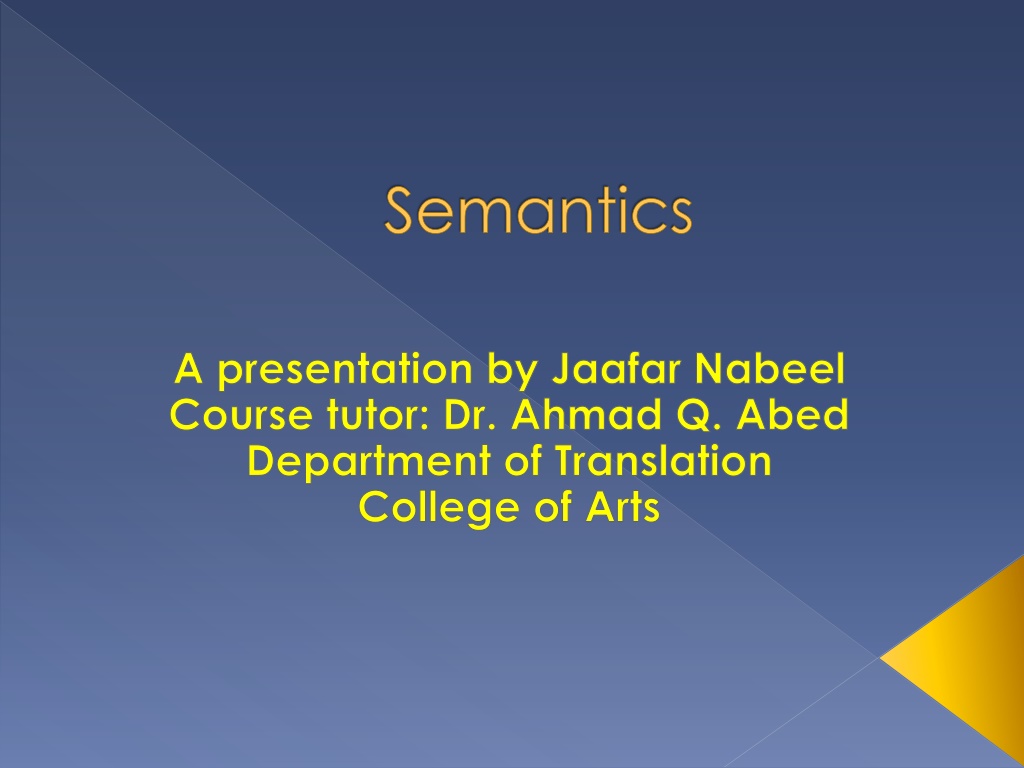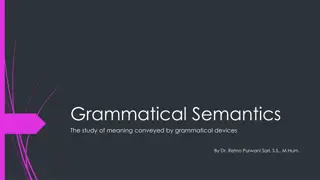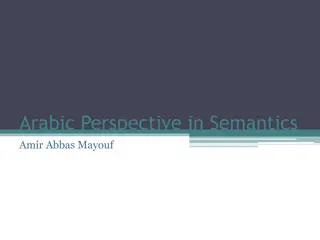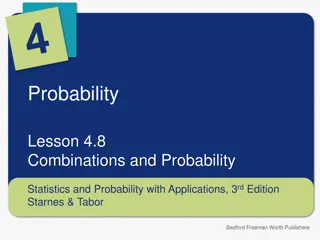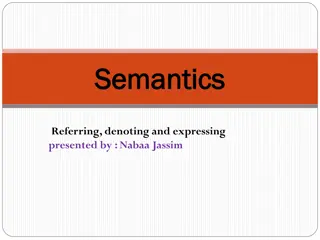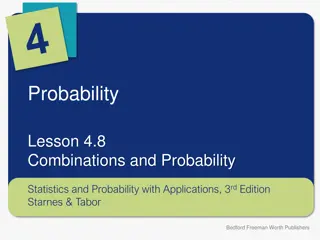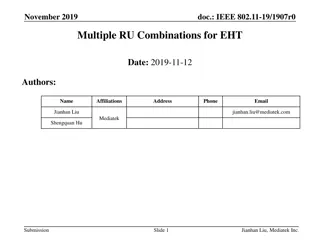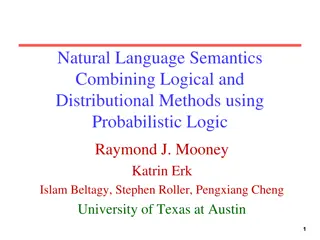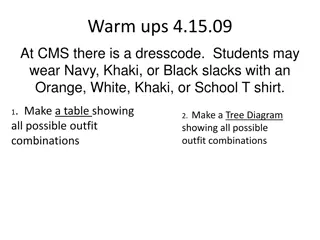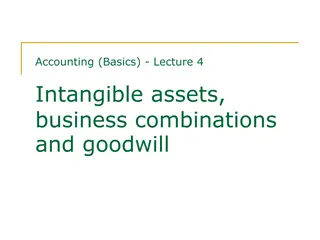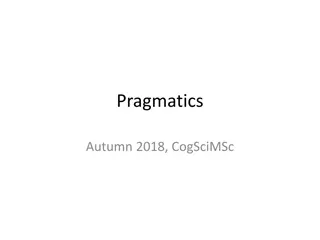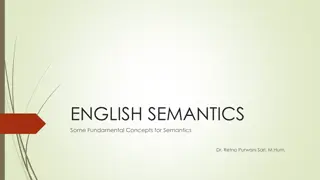Understanding Semantics: Principles and Combinations
Delve into the realm of semantics through this insightful presentation by Jaafar Nabeel. Explore the principle of compositionality, modes of combination, and endocentric combinations in linguistic analysis with clarity and depth.
Download Presentation

Please find below an Image/Link to download the presentation.
The content on the website is provided AS IS for your information and personal use only. It may not be sold, licensed, or shared on other websites without obtaining consent from the author. Download presentation by click this link. If you encounter any issues during the download, it is possible that the publisher has removed the file from their server.
E N D
Presentation Transcript
Semantics A presentation by Jaafar Nabeel Course tutor: Dr. Ahmad Q. Abed Department of Translation College of Arts
Outlines of the presentation Compositionality Linguistic and non-linguistic meaning
What is the principle of compositionality? It is basically a principle that deals with interpreting complex linguistic expressions In other words The meaning of a complex expression is determined by the structure and the meaning of its constituents
This principle is derived from two assumptions - The first assumption is that language has an infinite amount of grammatical sentences - The second one is that language has an unlimited power of expression Anything the mind conceives can be expressed
Modes of combination There are many ways to combine meanings Additive form of combination where meanings are added together without radical change in the combination Ex: [Mary and John] [studied the materials and passed the test]
Interactive from of combination sees at least one radical change in the combination. There are two forms of interactive combinations Endocentric combinations The eventual meaning is of the same type as the constituent. Exocentric combinations The eventual meaning is completely different than the constituents.
Endocentric combinations This form of combinations refers to the fact that the eventual meaning is of the same type as one of the constituents Endocentric combinations are divided into: Boolean combinations Relative descriptors Negational descriptors Indirect types
Boolean combination is the most elementary type of combination and is illustrated by the following example: Red hats The class of this phrase is constituted by the class of hats and the class of red things The usage of the word red restricted the applicability of hat.
Relative descriptors:- this type of combination is illustrated by the following example: A large mouse This phrase isn t interpreted as something that is large and mouse since all mice are small in their size! However, the meaning refers to a mouse that is relatively larger than others!
Negational descriptors: this type of combination is done by negating the head noun. A former president In the above phrase, we notice that the modifier former negated the head noun president.
Indirect types of combination require a more complex compositional process. A beautiful dancer The above phrase has two interpretations. The first interpretation is according to the Boolean combination and would be someone who is beautiful and also a dancer. The other interpretation requires a more semantic reconstruction of the phrase. the interpretation would be someone who dances beautifully.
Exocentric combinations This type of combination will result in a radically different meaning than its constituents that formed the combination. A combination between a preposition (in) which refers to a relation and a noun phrase (the box) which refers to a thing will result in a phrase denoting a place (in the box)
Limits to compositionality: non compositional expressions Semantic constituents are recognized by the recurrent contrast test. This test is based on the assumption that meaning implies choice and states that a semantic constituent can be substituted by some other constituent belonging to the same grammatical class. The girl plays tennis Tennis can be substituted by football changing the entire meaning
However, in a sentence such as: I want to read a novel We cannot substitute the word to here since its an obligatory element The recurrent contrast test would pass only in cases where it s possible to substitute a word
Idioms Idioms refer to expressions whose meaning is not compositional in the sense that its meaning doesn t follow the meaning of its constituents. Idioms usually have two different interpretations a literal and a figurative one Bury the hatchet The above example either mean the actual process of burying a hatchet which is a literal interpretation or figurative interpretation which means to make peace with someone. The figurative interpretation is the intended one when a native speaker uses this phrase.
Frozen metaphors are some kind of idiomatic expressions that possess some degree of compositionality. The ball is in your court now If we substitute in your court now with on your side of the net, we realize that the substitution has an effect; however, the non-literal meaning can still be recovered.
Collocations: the collocation of a word plays a major role in knowing its meaning in a context. Red in red rose which refers to the flower that is red whereas the red in red grapefruit refers to the color of the flesh of the fruit. Like idioms, collocations need to be understood individually. They need to be considered from the view point of the speaker and the viewpoint of the recipient.
Correct incorrect Heavy rain Great rain High speed Tall speed High wind Heavy wind
Clichs: the meaning of a clich is a phrase, expression, or idea which has been so overused to the point of losing its intended force. Characteristics of clich s: They are stored as complete units in the brain making them easy to retrieve and decode They tend to slip past without making a serious impact The truth and falsehood of them aren t seriously examined o o o Examples on clich s In the nick of time something that happened just in time Frightened to death to be too scared
Linguistic and non-linguistic meaning Linguistic communication is rather different than non-linguistic communication. In linguistic communication, we have the whole language to communicate with. However, the choices are limited when it comes to non-linguistic communication.
Aspects of linguistic communication: o The participants In each and every communicative situation, there are at least two participants who are the speaker and the recipient. o The medium of communication Medium here refers to the way or method used for communication o The topic of communication Setting and topic play a vital role in the communication process and decide the mood and the kind of language to be used
References Cruse, A.(2000). Meaning in Language: An Introduction to Semantics and Pragmatics. Oxford. Oxford University Press. http://mural.uv.es/emicha/semantica.html https://html.rincondelvago.com/compositionality-and- cognitive-semantics.html https://plato.stanford.edu/entries/compositionality/ http://www.masscommunicationtalk.com/how-you-would- differentiate-between-linguistics-and-non-linguistics- communication.html http://www.chauffeurdriven.com/news-features/in-this- issue/1264-7-aspects-of-nonverbal-communication.html
